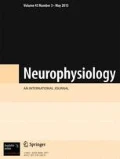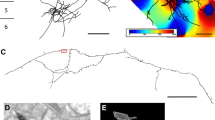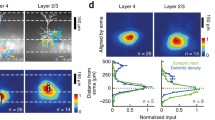Abstract
The role of convergence of sensory influences on unit activity in the association cortex during formation of temporal connection was investigated in experiments on unanesthetized cats. A bioelectrical model of temporal connection was produced after studying unit responses to direct electrical and peripheral stimulation (photic, acoustic, electrodermal, tactile, and proprioceptive). The results showed that 42% of neurons in the association cortex and about 90% of "trained" cells are polysensory. The role of convergence of sensory influences in the formation of microsystems of trained neurons of the association cortex and the microsystemic principle of organization of conditioning mechanisms are examined.
Similar content being viewed by others
Literature cited
P. K. Anokhin, The Biology and Neurophysiology of the Conditioned Reflex [in Russian], Meditsina, Moscow (1968).
N. N. Vasilevskii, "Functional properties distinguishing single neurons in the somatosensory cortex of adult rabbits and cats," Zh. Vyssh. Nerv. Deyat.,15, 529 (1965).
O. S. Vinogradova and D. Lindsley, "Increased response frequency to sensory stimuli in a single cortical neuron of the unanesthetized rabbit," Zh. Vyssh. Nerv. Deyat.,13, 207 (1963).
L. L. Voronin, Neurophysiological Mechanisms of the Plastic Properties of Cortical Neurons. Author's Abstract of Dissertation, Moscow (1971).
L. L. Voronin and V. G. Skrebitskii, "Extra- and intracellular investigation of unit responses in the motor cortex of the walking rabbit to acoustic and photic stimuli," Zh. Vyssh. Nerv. Deyat.,17, 523 (1967).
É. G. Zarkeshev, V. L. Silakov, and B. T. Moroz, "Role of the hippocampus in the regulation of fixation and retention of traces of combined stimuli in the cerebral cortex," Fiziol. Zh. SSSR,9, 154 (1974).
S. P. Narikashvili, V. S. Arutyunov, and É. Guma, "Characteristics of response activity of single neurons in the cat association cortex," Zh. Vyssh. Nerv. Deyat.,18, 865 (1968).
V. G. Skrebitskii and O. Z. Bomshtein, "Modulation of unit activity of the visual cortex of the waking rabbit by different nonvisual stimuli," Fiziol. Zh. SSSR,53, 129 (1967).
M. M. Khananashvili, Mechanisms of Normal and Pathological Conditioned-Reflex Activity [in Russian], Meditsina, Leningrad (1972).
M. M. Khananashvili, O. P. Voevodina, and É. G. Zarkeshev, "Integrated brain systems and cortical microsystems," Abstracts of Proceedings of the 11th Congress of the I. P. Pavlov All-Union Physiological Society [in Russian], Vol. 2, Moscow (1970), p. 121.
M. M. Khananashvili, É. G. Zarkeshev, and V. L. Silakov, "Manifestation of the effect of conditioning (formation of temporal connection) on cortical neurons isolated from subcortical influences," Fiziol. Zh. SSSR,57, 490 (1971).
A. Fessard, Electroencephalographic Investigations of Higher Nervous Activity [Russian translation], Izd. AN SSSR, Moscow (1962).
V. E. Amassian and R. de Vito, "Unit activity in reticular formation and nearby structures," J. Neurophysiol.,17, 575 (1954).
E. Bental and B. Bihari, "Evoked activity of single neurons in sensory association cortex of the cat," J. Neurophysiol.,26, 207 (1963).
O. D. Creutzfeldt and H. D. Lux, "Zur Unterscheidung von ‘spezifischen’ und ‘unspeczifischen’ Synapsen an corticalen Nervenzellen," Naturwissenschaften,51, 89 (1964).
R. Jung, H. H. Kornhuber, and J. S. Da Fonseca, "Multisensory convergence on cortical neurons," in: Progress in Brain Research. Brain Mechanisms, Vol. 1, Elsevier, Amsterdam (1963), pp. 207–234.
C.-L. Li, "Cortical intracellular synaptic potentials in response to thalamic stimulation," J. Cell. Comp. Physiol.,61, 165 (1963).
A. C. Nacimiento, H. D. Lux, and O. D. Creutzfeldt, "Postsynaptische Potentiale von Nervenzellen des motorischen Cortex nach electrischer Reizung specifischer und unspecifischer Thalamuskerne," Pflüg. Arch. ges. Physiol.,281, 152 (1964).
Additional information
Institute of Experimental Medicine, Academy of Medical Sciences of the USSR, Leningrad. Translated from Neirofiziologiya, Vol. 7, No. 2, pp. 141–148, March–April, 1975.
Rights and permissions
About this article
Cite this article
Zarkeshev, É.G., Silakov, V.L. & Khananashvili, M.M. Role of polymodal synaptic influences in temporal connection formation in neuronal microsystems of the association cortex. Neurophysiology 7, 107–112 (1975). https://doi.org/10.1007/BF01062855
Received:
Issue Date:
DOI: https://doi.org/10.1007/BF01062855




